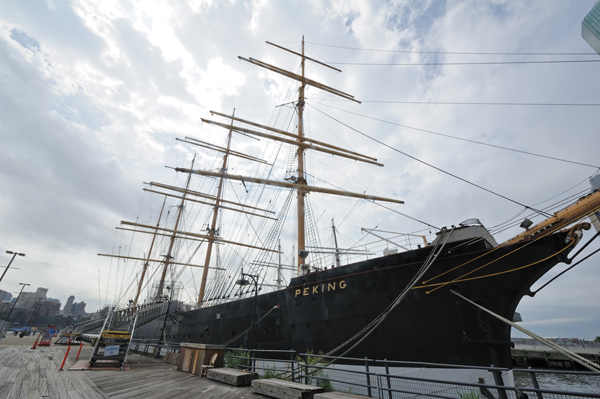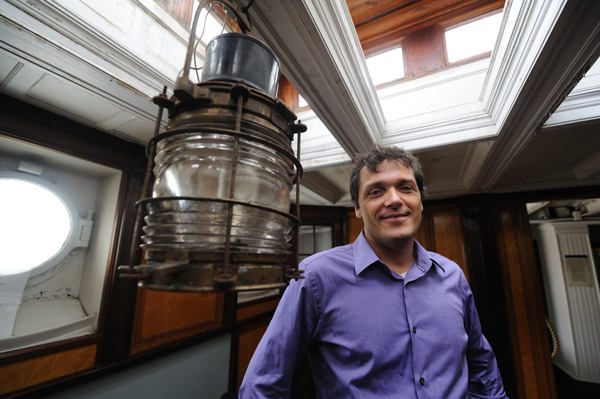
Downtown Express photo by Terese Loeb Kreuzer.
BY TERESE LOEB KREUZER | The masts and rigging of the South Street Seaport Museum’s clipper ship, Peking, tower over Pier 16. No visitor to the Seaport could miss seeing this titan that stretches almost the full length of the pier. But it has been years since members of the public have been able to climb aboard.
On Saturdays through Oct. 19, the Peking will be open to visitors from noon to 4 p.m.
“We are excited to have her open to the public again,” said Jonathan Boulware, interim president of the South Street Seaport Museum. “She is a magnificent ship. She’s not the only one [of this type] in the world, but she’s the only one in the United States.”
Peking was built in Hamburg, Germany 102 years ago to transport nitrate from the west coast of South America to Europe. Even at that time, sailing ships had mostly been replaced by steamships except for long trips with heavy cargo, where the cost of fuel would have been prohibitive.
She was built for F. Laeisz, a German company that still exists. She and her sister ships, whose names all began with the letter “P” were known as the “Flying P-Liners.”
Peking’s sister ship, Passat, laid down in the same year, carried 34 sails and could go up to 18 knots an hour under sail. Even so, Passat’s maiden voyage from Hamburg to Valparaiso, Chile, took 80 days.
The Peking’s capabilities would have been very similar. She was both fast and massive.
Standing on the Peking’s after-well deck, Boulware pointed out the Peking’s rig. “It’s magnificent,” he said, “and amazing to think that these are the same masts that sailors climbed in hurricanes and freezing conditions off of Cape Horn to get bird guano back to Europe in the 1920s. It’s hard to imagine as we sit here in the comparatively placid East River that this ship was actually rolled from side to side. The space where we’re standing now – you wouldn’t be able to stand. Her decks would be awash with water above our heads. This would be a washing machine of foaming water.”
Plywood covers what would have been the original deck or one installed soon thereafter. Under that is steel, and below that are Peking’s vast holds that would have been filled with cargo.
“In the famous movie made by Irving Johnson about Peking, he said, ‘Cargo is king. If you don’t arrive with a dry cargo, you might as well stay at home,’” Boulware remarked. “That’s the story of this ship. She wouldn’t exist if it weren’t for the fact that she carried around 3,100 tons of cargo.”
The captain and crew might have gone on successive voyages aboard Peking that would have taken them away for years at a time. Sometimes the captains brought their families with them. The captain’s quarters on the ship were partially restored after the South Street Seaport Museum acquired the ship in 1975.

The captain had a sitting room called a “saloon,” a spacious bedroom and a private bath. The saloon is paneled in mahogany and bird’s eye maple and has etched glass in the skylights. The first and second mates also had separate quarters, much smaller than the captain’s, but affording some privacy.
The crew of 21 to 30 seamen and ship boys shared accommodations and sleeping bunks in an area of the ship that is now an exhibition space. Visitors can see dramatic photographs of the ship under sail and photos of the storms that swept over the decks. Cape Horn, at the southern end of South America, is at the confluence of three oceans – the Atlantic, the Pacific and the Antarctic – and is one of the most treacherous stretches of sea on the globe. Waves can crest at 65 feet and many ships have been lost there.
The Peking successfully navigated these waters for years until trade through the Panama Canal put her out of business. In 1932, she was sold for use as a British children’s home and training school. She was repurposed during World War II to serve the Royal Navy. Finally, in 1975, her sailing days ended and the South Street Seaport Museum became her home.
“There are other examples of ships of this type built in Hamburg,” said Boulware. “One is still sailing. It’s a Russian flag sail training ship called Kruzenshtern.”
Peking’s sister ship, Passat, ended up in Travemünde in Germany, where she is a youth hostel, a museum ship and a local landmark.
Peking is not in good shape. It would take millions of dollars to repair her. Boulware said that a study of exactly how much it would cost has not been done.
“She is absolutely worth saving and she is savable,” he said. “But not by the museum. Not now.”
The Peking never actually called on New York, unlike the Seaport Museum’s other large cargo ship, the Wavertree, which exemplifies the kind of ship that would once have lined South St.
The museum has decided to put its efforts into rehabilitating the Wavertree and has been trying for years to repatriate Peking to Hamburg, where she was built. But so far, that hasn’t happened.
In the meantime, people who love this ship or who love history can use this unusual opportunity to go aboard the Peking. In addition, the museum is offering drop-in workshops on Peking’s visiting days. Woodcarver Sal Polisi will be in his shop on Water St, demonstrating his craft, while next door at Bowne & Co. Stationers, 211 Water St., Robert Warner will be offering drop-in collage workshops.
The museum is asking a suggested donation of $5, but more would be appreciated.

















